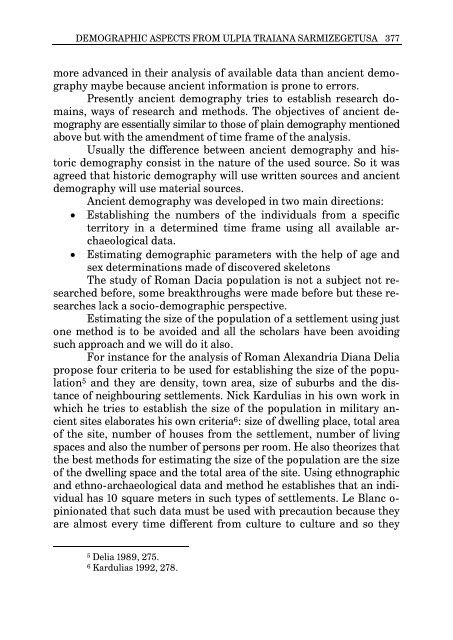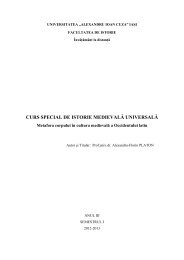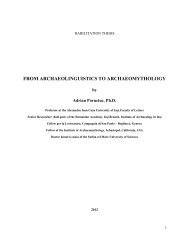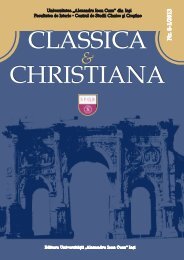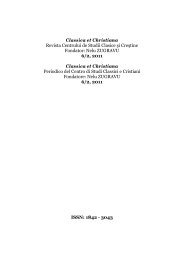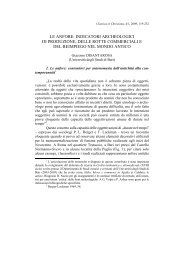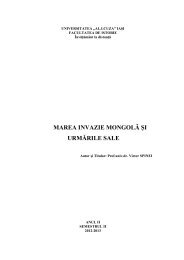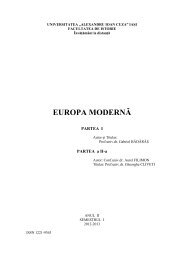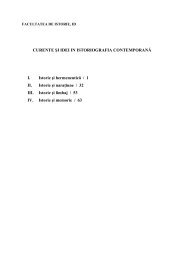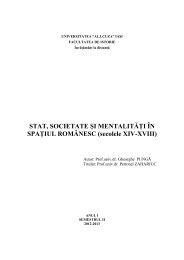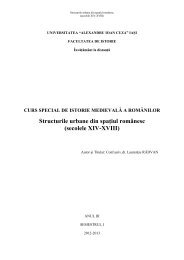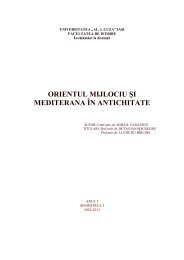- Page 3 and 4: Classica et Christiana Revista Cent
- Page 5 and 6: UNIVERSITATEA „ALEXANDRU IOAN CUZ
- Page 9 and 10: Classica et Christiana, 7/2, 2012,
- Page 11 and 12: SUMAR / INDICE SIGLE ŞI ABREVIERI
- Page 13: Classica et Christiana, 7/2, 2012,
- Page 16 and 17: 338 Marilena ABBATEPAOLO re è post
- Page 18 and 19: 340 Marilena ABBATEPAOLO però, gli
- Page 20 and 21: 342 Marilena ABBATEPAOLO l’humani
- Page 22 and 23: 344 Marilena ABBATEPAOLO comites la
- Page 24 and 25: 346 Marilena ABBATEPAOLO umanistica
- Page 26 and 27: 348 Marilena ABBATEPAOLO del re, «
- Page 28 and 29: 350 Marilena ABBATEPAOLO Fig. 1 Fig
- Page 31 and 32: Classica et Christiana, 7/2, 2012,
- Page 33 and 34: L’AMITA DE BELLICIUS À APULUM 35
- Page 35 and 36: L’AMITA DE BELLICIUS À APULUM 35
- Page 37 and 38: L’AMITA DE BELLICIUS À APULUM 35
- Page 39 and 40: 15 Q. Aemilius Maximus, Aemilia Res
- Page 41 and 42: L’AMITA DE BELLICIUS À APULUM 36
- Page 43 and 44: L’AMITA DE BELLICIUS À APULUM 36
- Page 45 and 46: L’AMITA DE BELLICIUS À APULUM 36
- Page 47 and 48: L’AMITA DE BELLICIUS À APULUM 36
- Page 49 and 50: L’AMITA DE BELLICIUS À APULUM 37
- Page 51 and 52: L’AMITA DE BELLICIUS À APULUM 37
- Page 53: Classica et Christiana, 7/2, 2012,
- Page 57 and 58: DEMOGRAPHIC ASPECTS FROM ULPIA TRAI
- Page 59 and 60: DEMOGRAPHIC ASPECTS FROM ULPIA TRAI
- Page 61 and 62: Classica et Christiana, 7/2, 2012,
- Page 63 and 64: DIE EREIGNISSE AN DER WESTGRENZE DE
- Page 65 and 66: DIE EREIGNISSE AN DER WESTGRENZE DE
- Page 67 and 68: DIE EREIGNISSE AN DER WESTGRENZE DE
- Page 69 and 70: DIE EREIGNISSE AN DER WESTGRENZE DE
- Page 71 and 72: DIE EREIGNISSE AN DER WESTGRENZE DE
- Page 73 and 74: DIE EREIGNISSE AN DER WESTGRENZE DE
- Page 75 and 76: DIE EREIGNISSE AN DER WESTGRENZE DE
- Page 77 and 78: DIE EREIGNISSE AN DER WESTGRENZE DE
- Page 79 and 80: DIE EREIGNISSE AN DER WESTGRENZE DE
- Page 81 and 82: DIE EREIGNISSE AN DER WESTGRENZE DE
- Page 83 and 84: DIE EREIGNISSE AN DER WESTGRENZE DE
- Page 85 and 86: Farcas, Torbágyi 2008 Gudea Moţu,
- Page 87: DIE EREIGNISSE AN DER WESTGRENZE DE
- Page 90 and 91: 412 Nicola BIFFI Non si tratta, per
- Page 92 and 93: 414 Nicola BIFFI di sostenere finan
- Page 94 and 95: 416 Nicola BIFFI IX) la sovranità
- Page 96 and 97: 418 Nicola BIFFI con Gabinio, da ne
- Page 98 and 99: 420 Nicola BIFFI spina nel fianco d
- Page 100 and 101: 422 Nicola BIFFI Allorché, infatti
- Page 102 and 103: 424 Nicola BIFFI non ostante ciò,
- Page 104 and 105:
426 Nicola BIFFI rilevanza storica
- Page 106 and 107:
428 Nicola BIFFI menia 85 . Sembrav
- Page 108 and 109:
430 Nicola BIFFI all’impero roman
- Page 110 and 111:
432 Dan DANA, Sorin NEMETI commence
- Page 112 and 113:
434 Dan DANA, Sorin NEMETI Dans une
- Page 114 and 115:
436 Dan DANA, Sorin NEMETI Dans ces
- Page 117 and 118:
Classica et Christiana, 7/2, 2012,
- Page 119 and 120:
Kličevac: CULT OF JUPPITER DOLICHE
- Page 121 and 122:
CULT OF JUPPITER DOLICHENUS IN THE
- Page 123:
CULT OF JUPPITER DOLICHENUS IN THE
- Page 126 and 127:
448 Xavier LAPRAY mutations tactiqu
- Page 128 and 129:
450 Xavier LAPRAY une grande impét
- Page 130 and 131:
452 Xavier LAPRAY corps civique - c
- Page 132 and 133:
454 Xavier LAPRAY ne conduit pas im
- Page 134 and 135:
456 Xavier LAPRAY manœuvre conjoin
- Page 136 and 137:
458 Xavier LAPRAY sente un peu moin
- Page 138 and 139:
460 Xavier LAPRAY manipulaire: la g
- Page 140 and 141:
462 Xavier LAPRAY moment de la guer
- Page 142 and 143:
464 Xavier LAPRAY Romains en 216, q
- Page 144 and 145:
466 Xavier LAPRAY outre placé au d
- Page 146 and 147:
468 Xavier LAPRAY d’un intérêt
- Page 148 and 149:
470 Xavier LAPRAY nombreuses comme
- Page 150 and 151:
472 Xavier LAPRAY Si le dispositif
- Page 152 and 153:
474 Xavier LAPRAY d’égalisation
- Page 154 and 155:
476 Xavier LAPRAY d’une plus gran
- Page 156 and 157:
478 Xavier LAPRAY manière fort ré
- Page 159 and 160:
Classica et Christiana, 7/2, 2012,
- Page 161 and 162:
COLUMELLA: LO SCIENZIATO E L’ARTI
- Page 163 and 164:
COLUMELLA: LO SCIENZIATO E L’ARTI
- Page 165 and 166:
COLUMELLA: LO SCIENZIATO E L’ARTI
- Page 167 and 168:
COLUMELLA: LO SCIENZIATO E L’ARTI
- Page 169 and 170:
COLUMELLA: LO SCIENZIATO E L’ARTI
- Page 171 and 172:
COLUMELLA: LO SCIENZIATO E L’ARTI
- Page 173 and 174:
COLUMELLA: LO SCIENZIATO E L’ARTI
- Page 175 and 176:
COLUMELLA: LO SCIENZIATO E L’ARTI
- Page 177:
COLUMELLA: LO SCIENZIATO E L’ARTI
- Page 180 and 181:
502 Olga MONNO orientamento esegeti
- Page 182 and 183:
504 Olga MONNO contenitore dell’a
- Page 184 and 185:
506 Olga MONNO tuno 12 : in entramb
- Page 186 and 187:
508 Olga MONNO sperimentabile, il s
- Page 188 and 189:
510 Olga MONNO Vediamo innanzi tutt
- Page 190 and 191:
512 Olga MONNO est ab eo quod conti
- Page 192 and 193:
514 Olga MONNO glierne appieno la f
- Page 194 and 195:
516 Olga MONNO terpretazione in sen
- Page 196 and 197:
518 Olga MONNO la formazione preval
- Page 198 and 199:
520 Domenica Paola ORSI Il signific
- Page 200 and 201:
522 Domenica Paola ORSI Il satrapo
- Page 202 and 203:
524 Domenica Paola ORSI Nei due pas
- Page 204 and 205:
526 Domenica Paola ORSI s…a. Non
- Page 206 and 207:
528 Domenica Paola ORSI - Pure, ti
- Page 208 and 209:
530 Domenica Paola ORSI trasferisce
- Page 210 and 211:
532 Domenica Paola ORSI Arcadi eran
- Page 212 and 213:
534 Domenica Paola ORSI crileghi. N
- Page 214 and 215:
536 Domenica Paola ORSI stribuiva i
- Page 216 and 217:
538 Liviu PETCU texte-cheie asupra
- Page 218 and 219:
540 Liviu PETCU Din perspectiva lui
- Page 220 and 221:
542 Liviu PETCU Natura umană, dup
- Page 222 and 223:
544 Liviu PETCU adecvată (1.151, 1
- Page 224 and 225:
546 Liviu PETCU cru bun este lipsit
- Page 226 and 227:
548 Liviu PETCU poate gândi cineva
- Page 228 and 229:
550 Liviu PETCU tă timpurilor (1.3
- Page 230 and 231:
552 Liviu PETCU nu este întrerupt
- Page 232 and 233:
554 Liviu PETCU ra eternul numai pr
- Page 234 and 235:
556 Liviu PETCU orice, în concepţ
- Page 236 and 237:
558 Liviu PETCU Tatăl şi Dumnezeu
- Page 238 and 239:
560 Liviu PETCU aceea că aventura
- Page 241 and 242:
Classica et Christiana, 7/2, 2012,
- Page 243 and 244:
LE PASSAGE DES CELTES PAR LA DARDAN
- Page 245 and 246:
LE PASSAGE DES CELTES PAR LA DARDAN
- Page 247 and 248:
LE PASSAGE DES CELTES PAR LA DARDAN
- Page 249 and 250:
Classica et Christiana, 7/2, 2012,
- Page 251 and 252:
LA FEMME DANS LA DACIE ROMAINE ment
- Page 253 and 254:
LA FEMME DANS LA DACIE ROMAINE est
- Page 255 and 256:
LA FEMME DANS LA DACIE ROMAINE ans)
- Page 257 and 258:
LA FEMME DANS LA DACIE ROMAINE La f
- Page 259 and 260:
LA FEMME DANS LA DACIE ROMAINE 1975
- Page 261 and 262:
LA FEMME DANS LA DACIE ROMAINE 5, f
- Page 263 and 264:
Fig. 5 LA FEMME DANS LA DACIE ROMAI
- Page 265 and 266:
Fig. 11 LA FEMME DANS LA DACIE ROMA
- Page 267 and 268:
Fig. 17 Fig. 18/a LA FEMME DANS LA
- Page 269 and 270:
Classica et Christiana, 7/2, 2012,
- Page 271 and 272:
NOTE SULLA TRADIZIONE DEI GRAECA NE
- Page 273:
NOTE SULLA TRADIZIONE DEI GRAECA NE
- Page 276 and 277:
598 Nelu ZUGRAVU Mântuitorul nu a
- Page 278 and 279:
600 Nelu ZUGRAVU uscată cu sare ş
- Page 280 and 281:
602 Nelu ZUGRAVU de apă 26 . Cazul
- Page 282 and 283:
604 Nelu ZUGRAVU ră (omnes se infe
- Page 284 and 285:
606 Nelu ZUGRAVU mite, bea apă, ca
- Page 286 and 287:
608 Nelu ZUGRAVU să se roage, să
- Page 288 and 289:
610 stareţul (Bourges) († 577) C
- Page 290 and 291:
612 (Alexandria) Alexandra „cele
- Page 292 and 293:
614 O fecioară anonimă Iacob din
- Page 294 and 295:
616 Paul cel Mare, primul eremit p
- Page 296 and 297:
618 RECENZII / RECENSIONI ximianus,
- Page 298 and 299:
620 RECENZII / RECENSIONI jeures se
- Page 300 and 301:
622 RECENZII / RECENSIONI vons prat
- Page 302 and 303:
624 RECENZII / RECENSIONI utile dan
- Page 304 and 305:
626 RECENZII / RECENSIONI calypse d
- Page 306 and 307:
628 RECENZII / RECENSIONI D. Gonnet
- Page 308 and 309:
630 RECENZII / RECENSIONI prin cât
- Page 310 and 311:
632 RECENZII / RECENSIONI cu cele m
- Page 312 and 313:
634 RECENZII / RECENSIONI 2002-2003
- Page 314 and 315:
636 RECENZII / RECENSIONI La final,
- Page 316 and 317:
638 RECENZII / RECENSIONI Pratiche
- Page 318 and 319:
640 RECENZII / RECENSIONI medica de
- Page 320 and 321:
642 RECENZII / RECENSIONI una masca
- Page 322 and 323:
644 RECENZII / RECENSIONI parţinâ
- Page 324 and 325:
646 CRONICA / CRONACA 6 octombrie 2
- Page 326 and 327:
648 CRONICA / CRONACA 2. Publicaţi
- Page 328 and 329:
650 CRONICA / CRONACA - La diarchia
- Page 330 and 331:
652 CRONICA / CRONACA 5. Distincţi
- Page 332 and 333:
654 PUBLICAŢII / PUBBLICAZIONI - C


